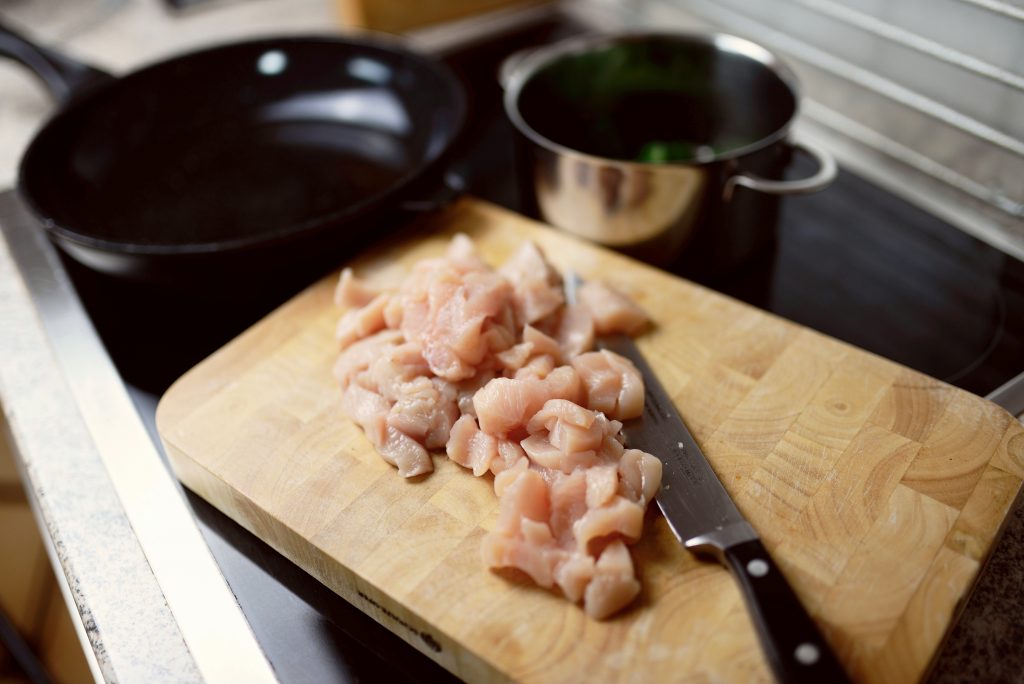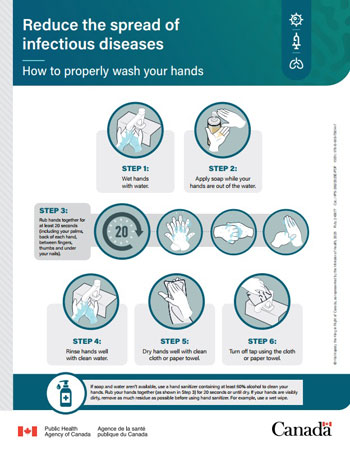
Handling food safely in your home will prevent foodborne illnesses that can cause food poisoning.
There are 4 main steps to handling food safely:
- Clean
- Separate
- Cook
- Chill
CLEAN
Handwashing is the #1 way to prevent food poisoning.
Cleaning the surfaces used in preparing and cooking food will prevent cross-contamination and the possible transfer of bacteria.
What is cross contamination?
Cross contamination is the transfer of bacteria from one surface to another. In the kitchen, cross-contamination can occur in 3 ways:
a) Food-to-food (example raw meat juices dripping on lettuce)
b) Person-to-food (example person who handled raw meat did not wash their hands and then touched cooked food/ready to eat foods)
c) Object-to-food (example dirty cutting board, utensils, etc. being used to prepare/serve cooked/ready to eat foods)
To reduce the possibility of cross-contamination:
- Keep raw meats and produce apart by keeping cutting boards and utensils separate.
- Wash surfaces like countertops, cutting boards and utensils regularly. Clean all surfaces that may be in contact with food. Cleaning should be done before, during and after the cooking/preparation process.
- Wash hands frequently to stop the spread of germs and bacteria
- when you begin food preparation
- after handling raw meats
- anytime you touch other surfaces like the phone, your face/hair, pets or if you use the washroom or change a diaper.
Read Information about hand hygiene and the proper steps to washing hands from the Public Health Agency of Canada.

SEPARATE
Raw meats must be separated from other foods in your shopping cart, and in your fridge as they can spread harmful bacteria in your kitchen if they are not handled properly.
- Keep raw meats in sealed bags or containers so juices do not drip onto other foods.
- Use a separate cutting board for meats to avoid cross-contamination.
- Always wash your hands after handling raw meat.
- Use separate plates for raw and cooked food.
- If you are marinating raw meat, the marinade must be boiled first if you want to use it as a sauce on the cooked meat. Boiling the marinade will kill any harmful bacteria and make the sauce safe to eat.
COOK
Meat, poultry, fish and seafood must be cooked thoroughly and to the proper temperature to reduce the risk of food borne illness.
- You can use a digital food or meat thermometer to check the internal temperature of foods. Doneness is determined by checking the temperature. Stick the thermometer into the thickest part of the meat, avoiding the bone.
Safe Cooking Temperatures
| FOOD | TEMPERATURE |
| Poultry | |
| Pieces (drumsticks, breasts, thighs) | 165°F (74°C) |
| Ground Chicken or Turkey | 165°F (74°C) |
| Whole bird, Chicken, turkey, duck, goose | 180°F (82°C) |
| Stuffing (cooked alone or in bird) | 165°F (74°C) |
| Frozen raw breaded chicken (nuggets) | 165°F (74°C) |
| Beef, Veal and Lamb | |
| Pieces and whole cuts (steaks, roast) | 145°F (63°C) medium-rare |
| 160°F (71°C) medium | |
| 170°F (77°C) well done | |
| Ground Beef (burgers, meatballs) | 160°F (71°C) |
| Pork | |
| Pieces and whole cuts (pork chops, roast) | 160°F (71°C) |
| Ground Pork | 160°F (71°C) |
| Ham | 160°F (71°C) |
| Fish and Seafood | |
| Fish, all types | 158°F (70°C) |
| Shellfish (shrimp, lobster, crab, scallops, mussels and oysters) | 165°F (74°C) Discard any that do not open in cooking |
| Game Meats | |
| Deer, Elk, Moose | 165°F (74°C) |
| Bison | 165°F (74°C) |
| Game Birds and Waterfowl | |
| Whole bird (pheasant, wild turkey, goose, or duck) | 180°F (82°C) |
| Pieces (drumsticks, breasts, thighs) | 165°F (74°C) |
Read more on cooking Manitoba meat products from these local organizations:
Manitoba Chicken Producers: Cooking Chicken
Manitoba Pork: Safe Food Handling
Manitoba Turkey: Cooking Canadian Turkey
Manitoba Beef Producers: Canada Beef Cooking Know How
CHILL (Refrigerate Promptly)
Cold foods must be kept cold at a temperature of 4°C / 40°F or colder. This is important in shopping, getting your groceries home and storing and using foods. If foods are not kept cold, harmful bacteria can begin to grow.
Shopping
- In the grocery store, pick up the refrigerated and frozen items last so they don’t warm up while you are shopping.
- Go directly home with groceries and put food straight into the fridge or freezer.
- In the summer, consider taking an insulated shopping bag or cooler to protect your cold foods in transport.
Storage
- If you are storing meat in the fridge, make sure the packaging is not leaking juices onto other food. Keep raw uncooked meat on the bottom shelf.
- For information on how long food should be refrigerated or frozen, read the articles Safe Food Storage and Top Tips for Storing Fresh Food.
Safe Freezing and Thawing
- If you are planning to freeze meats (especially if bought in large value packs), separate meat into freezer bags in the desired portion amounts. Label the freezer bags with contents and date so it will be easy to identify after it is frozen (for example, 4 Chicken breasts, July 13, 2025).
- Never defrost food on the counter at room temperature. There are three safe ways to defrost food: in the refrigerator, in cold water, or in the microwave using the defrost setting. Raw meats and seafood that are thawed should be cooked right away. Read more about safe thawing in our article Safe Food Storage or in the Government of Canada article, Safely Defrosting Foods.
Not only do cold foods need to stay cold, but hot foods need to stay hot, at 60°C / 140°F or above, to stay out of the danger zone where bacteria starts to grow. Bacteria grows rapidly in the ‘danger zone’ between 4°C and 60°C (40°F and 140°F).
Leftovers
- Store any leftovers properly. Transfer any uneaten food into shallow containers that will cool quickly and store in the refrigerator as soon as possible.
- The longer food is kept at room temperature, the greater risk of bacterial growth in the food. The goal is to have food cooled and placed in the refrigerator within 2 hours of cooking. For more information, read Food safety tips for leftovers.
- If you are bringing home leftovers from a restaurant, put them in the fridge as soon as possible.
OTHER TIPS FOR SAFE FOOD STORAGE:
- Clean your kitchen regularly. This includes the refrigerator, freezer, cupboards and pantry. Check for foods that may be spoiling or ones that need to be used right away before they spoil.
- In the fridge and freezer, try not to pack all of the food tightly together and allow for air to flow through.
- Store dried goods (cans, dried pasta/rice, crackers, etc.) in a cool dry place. Prior to opening cans, inspect them for dents, swelling and rust. If the can appears to be damaged in any way, throw it out. Once cans are opened, if you are not going to eat the entire contents right away, empty them into a glass bowl, cover and refrigerate.
For more information on safe food storage, visit this page from the Canadian Food Inspection Agency. You can also read more in the Manitoba Association of Home Economists article Safe Food Storage.
Other Related Resources
Interactive Guide to Safe Food Handling from Health Canada
Food Safety at Home from the Winnipeg Regional Health Authority
Kitchen Tips and Food Handling Videos from the Dietitians of Canada
Read these articles next:
Top Tips for Storing Fresh Food
Safe Food Storage






